-
Car Reviews
- All reviews
- Midsize SUVs
- Small cars
- Utes
- Small SUVs
- Large SUVs
- Large cars
- Sports SUVs
- Sports cars
- Vans
Latest reviews
- Car News
-
Car Comparisons
Latest comparisons
- Chasing Deals
Are Australians ready for a plus-sized plug-in hybrid dual cab ute? GWM gives us a taste of the Cannon Alpha PHEV on Aussie soil ahead of its likely 2025 introduction.
Like it or not, plug-in hybrid dual cab utes are coming. Ford’s Ranger PHEV and the BYD Shark plug-ins are a few months away – each allying a petrol engine with a battery-fed electric motor – and it looks likely a larger alternative will follow in the shape of GWM’s Cannon Alpha PHEV.
The Chinese brand shipped in a left-hand-drive 4×4 Cannon Alpha Hi4T PHEV for GWM’s Australian team to evaluate, and gave we journos a quick taste, but sadly not on public roads. We used Queensland’s Norwell Motorplex, featuring a short but very varied off-road course, plus its mirror-smooth bitumen circuit.
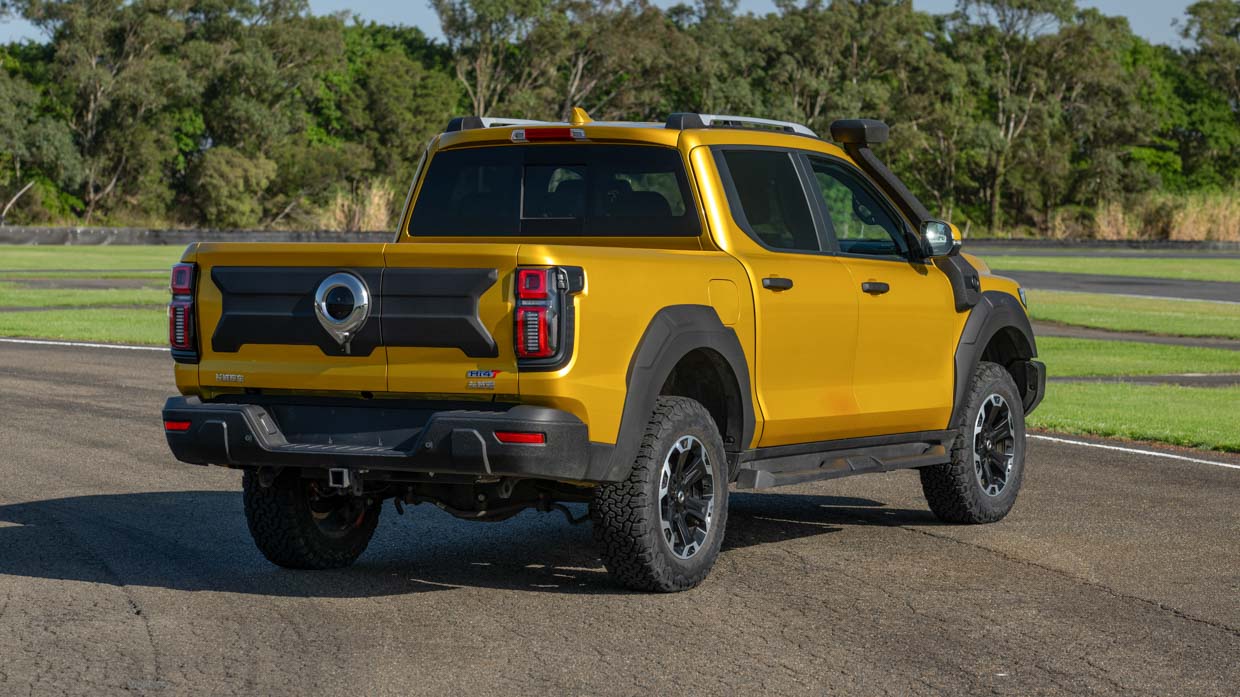
This is not great for an in-depth evaluation, but it’s a fair taste of this plus-size plug-in dual cab on Aussie soil to see if adds something truly worthwhile to our brim-filled ute and pickup market.
Why a PHEV ute? This 2775kg whopper uses a sizeable 37.1kWh battery, feeding a 120kW/400Nm electric motor. That brings a pure electric range (WLTP) of 110km, which is highly impressive in PHEV land, not least considering the Cannon’s mass.
Then there’s fringe benefit tax (FBT) exemption if it’s kept under the $91,387 Luxury Car Tax threshold for fuel-efficient vehicles (it will be).
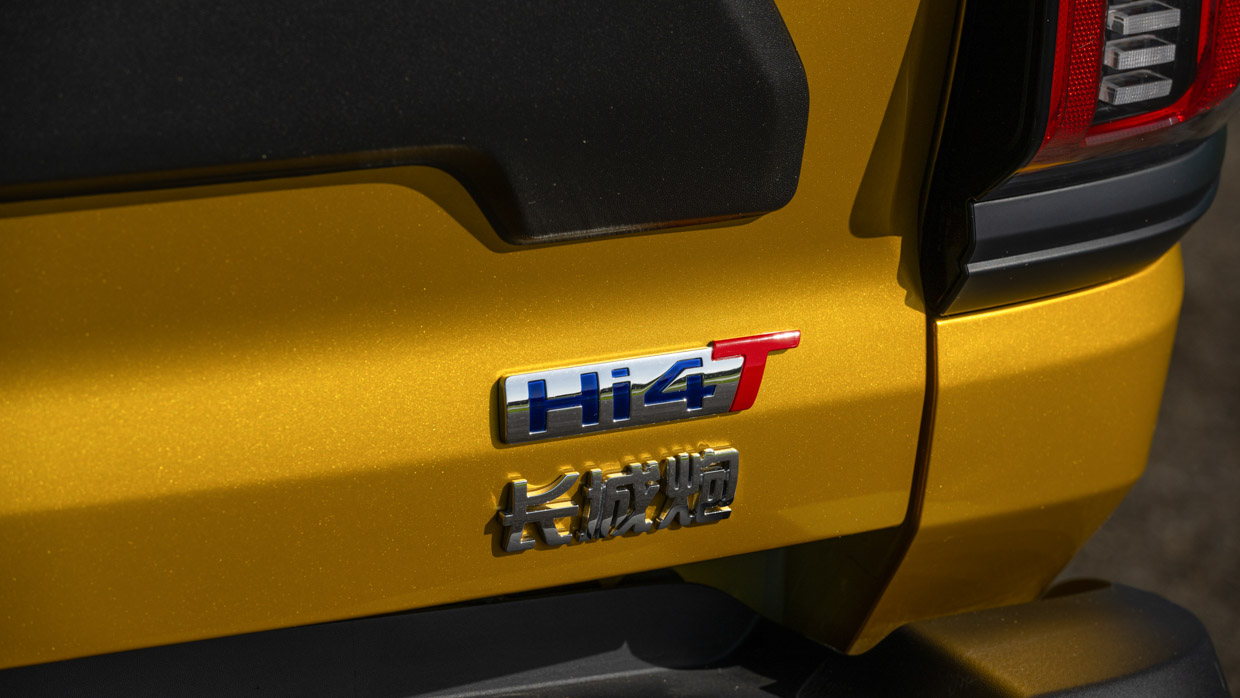
Of course it’ll cost more than the current $64,990 drive-away Cannon Alpha Hybrid, but if this PHEV is $75,000 or even $80,000, there are substantial savings to be had under those FBT incentives.
PHEVs polarise opinion, but for some they can be a sweet spot between combustion power and full electric vehicles. From a working ute perspective, short journeys can be done emissions free if it’s been charged using solar, while it offers 4×4 off-road adventuring in blissful, tree-hugging silence if the petrol engine never fires up.
With this Cannon Alpha PHEV’s 180kW/380Nm single-turbo petrol 2.0L four-cylinder backing the electric motor, there’s a combined 300kW and 750Nm. That’s a 16 per cent and 17 per cent increase over a normal hybrid model.
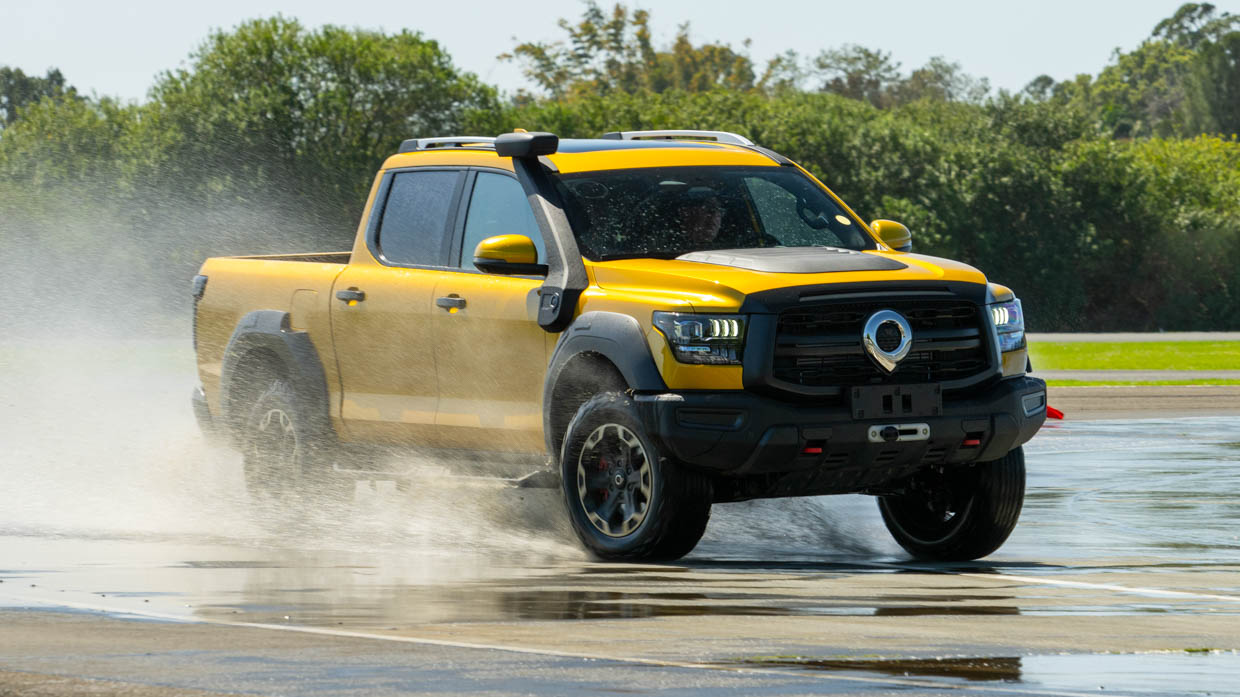
From a towing perspective, with battery fully charged, there’s ample guts. Tow rating’s a mighty 3500kg, although payload’s a disappointing 535kg, mainly due to heavy batteries stored under the ute tub.
Other figures sound better. There’s 800mm wading depth, 224mm ground clearance, approach, breakover and departure angles are fair at 28.5, 19 and 23 degrees respectively, while acceleration’s an eager 6.9 seconds to 100km/h.
The Cannon Alpha’s a larger truck than the likes of a HiLux or Ranger, and GWM’s own diesel Cannon one-tonner. It’s not as hulking as a Ram or Ford F-150, so see it as a ute inbetweener.
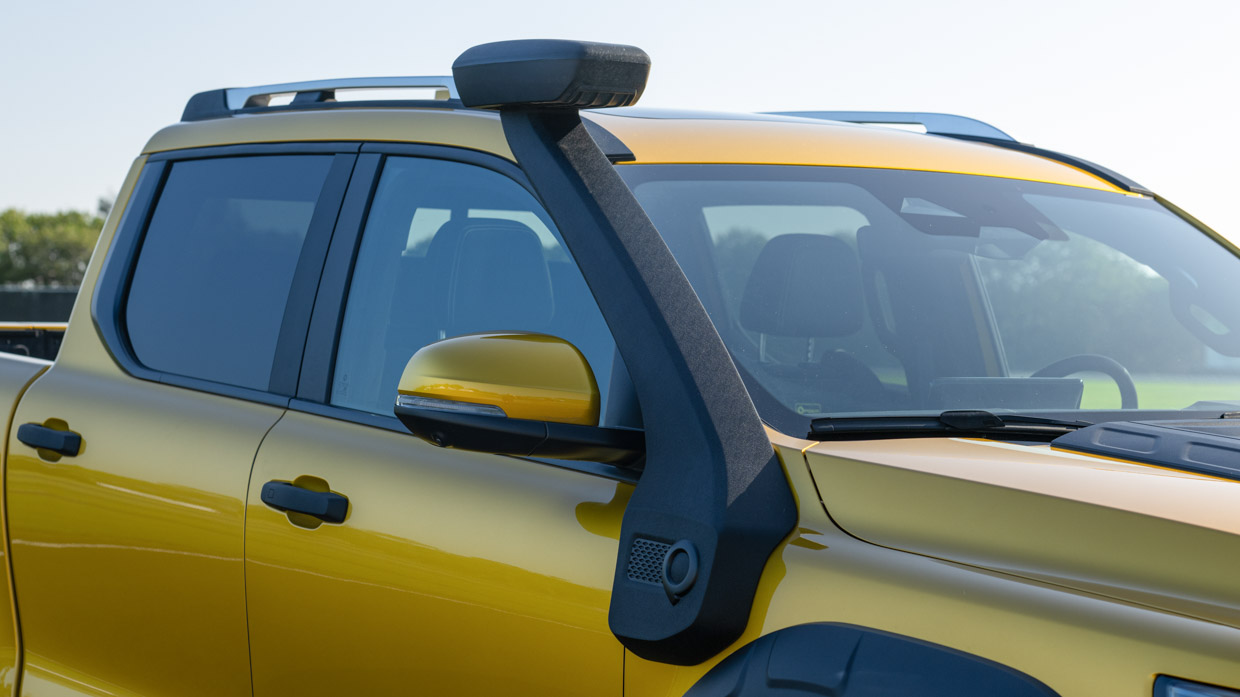
It’s an imposing thing in the metal, with an in-yer-face front grille and central Cannon badge the size of your head. Our test PHEV was the flagship XSR, with an interior lined with luxe and off-road components to make it highly suited (and desirable) for Aussie life. You’d fancy it’d be the model most likely to get the cashed-up 4×4 mob excited.
There are two front recovery points, a winch in the steel bumper, underbody bash plates, the largest snorkel you’ve ever seen, all-terrain tyres, off-road suspension, metal side steps and, unlike the series-parallel hybrid Cannon Alpha current only sale, coil spring rather than leaf rear suspension. There are ventilated brake discs all round too.
A cool feature is the Alpha’s split tailgate. Press and hold a rear button and it drops conventionally, or a gentle tap has only one side open on a side hinge.
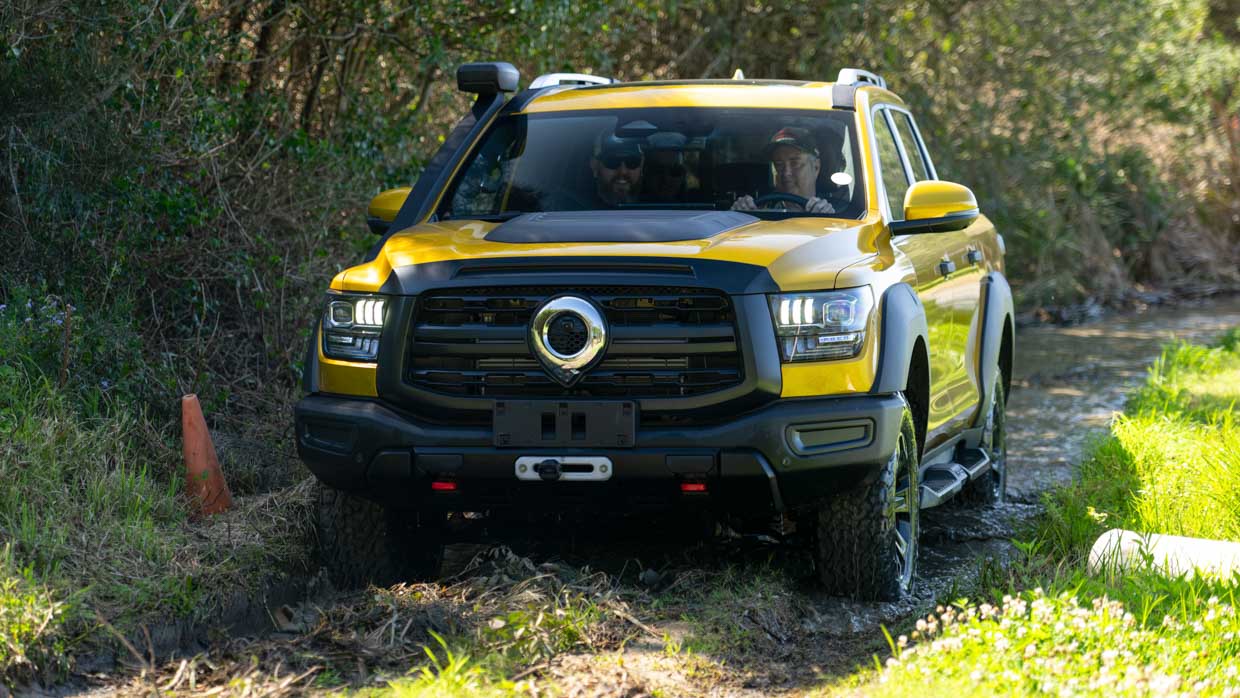
Inside is a protective-sprayed tub liner, plus a damn useful domestic power socket thanks to this PHEV’s V2L (vehicle-to-load) capability. Charging an electric bike, inflating an air mattress or powering a fridge just became a lot easier.
There’s a petrol cap one side, and charge ports the other. It handles DC charging, up to 50kW, and we’re promised the battery goes from 30-80 per cent charge in 24 minutes this way. An AC port, if using a home wall box, delivers near empty to full in 6.5 hours.
To the drive. There’s no hiding the off-road intentions here. There’s a low range transfer case plus centre, rear and front diff lock, all operated through a busy centre console panel.
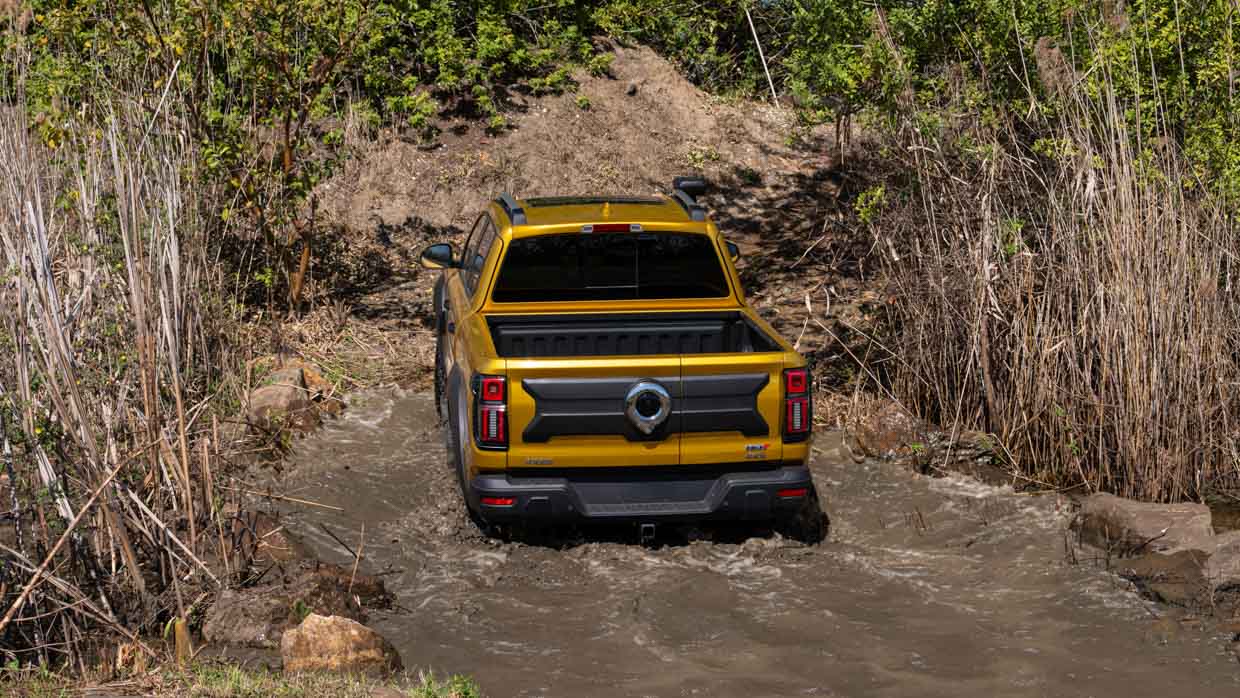
Most intriguing is being able to travel solely using the electric motor. We had numerous false starts trying to select and hold it in EV driving mode only – all the screen’s controls were in Chinese, sadly.
It appeared once the ute was at a certain angle or when more propulsion was needed, the petrol fired up for power and control backup, but hopefully a production version for us would lock the vehicle in pure electric drive until the operator decides otherwise.
It’s all rather blissful, and a dash strange. Climbing up a serious incline, then through water, sand and over rocks, there’s no noise from the powertrain. Zilch. Just the sound of things being moved under the giant tyres and some of the mechanicals at work. Windows down or through the sunroof you can peacefully take in the sounds of nature.
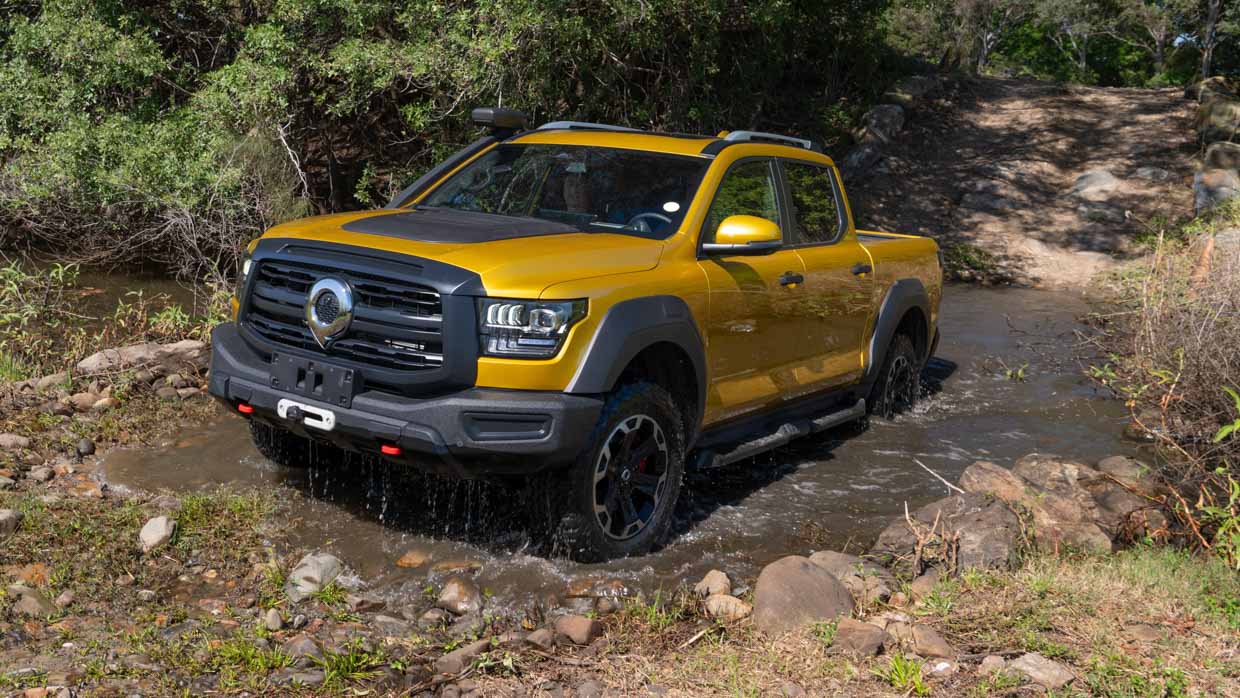
The Alpha PHEV feels well insulated, and it takes some getting used to no diesel rattle nor petrol rumble.
Another win is overall comfort. Spongy seats and compliant suspension means you’re not pounded around over obstacles, and with a wheel in the air the drivetrain ensures torque is sent to the on-terrain ones for fuss-free progress.
Well, apart from the hard-to-shut-up driver assist and driver monitoring. You also must shut down front and side obstacle warnings or it becomes a beeping swarm, but this will prove a lot easier once we get an English language screen.
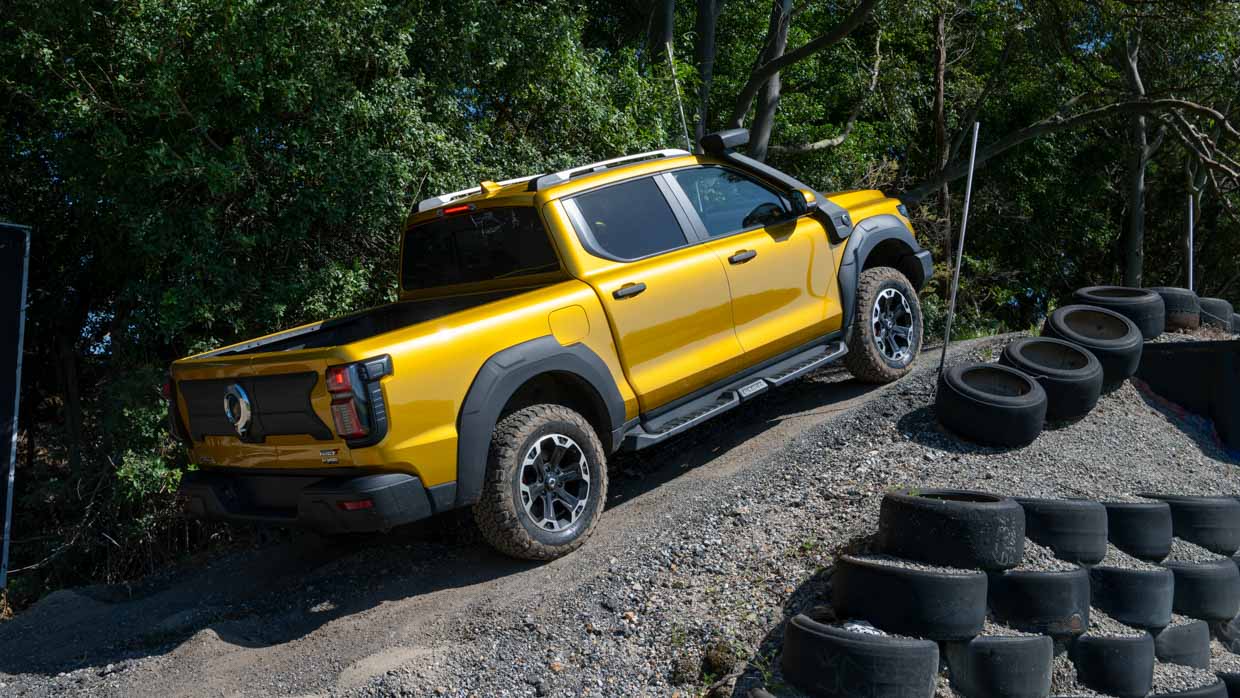
Ripe for praise are the cameras. These show your sides, front, rear and overhead, and the giant central screen can be split to show numerous angles. It creates a transparent picture of the vehicle, showing obstacles beneath and ahead should your nose be pointing skywards.
Our off-road course was relatively easy compared to what many Aussies put their 4x4s through, so just how capable – and reliable – this PHEV would be will need far more exhaustive evaluation. But early signs are good, and the safety testing – crush, submersion, high-pressure and fire – appears to have been exhaustive.
Not a great deal could be learned on Norwell’s paved surface, it being near bump-free and not at all representative of most Aussie roads. It’s a lumbering big beast in corners and felt a bit wobbly, but this is nothing unusual for a massive pickup. Steering’s very light and – its size aside – feels easy to drive.
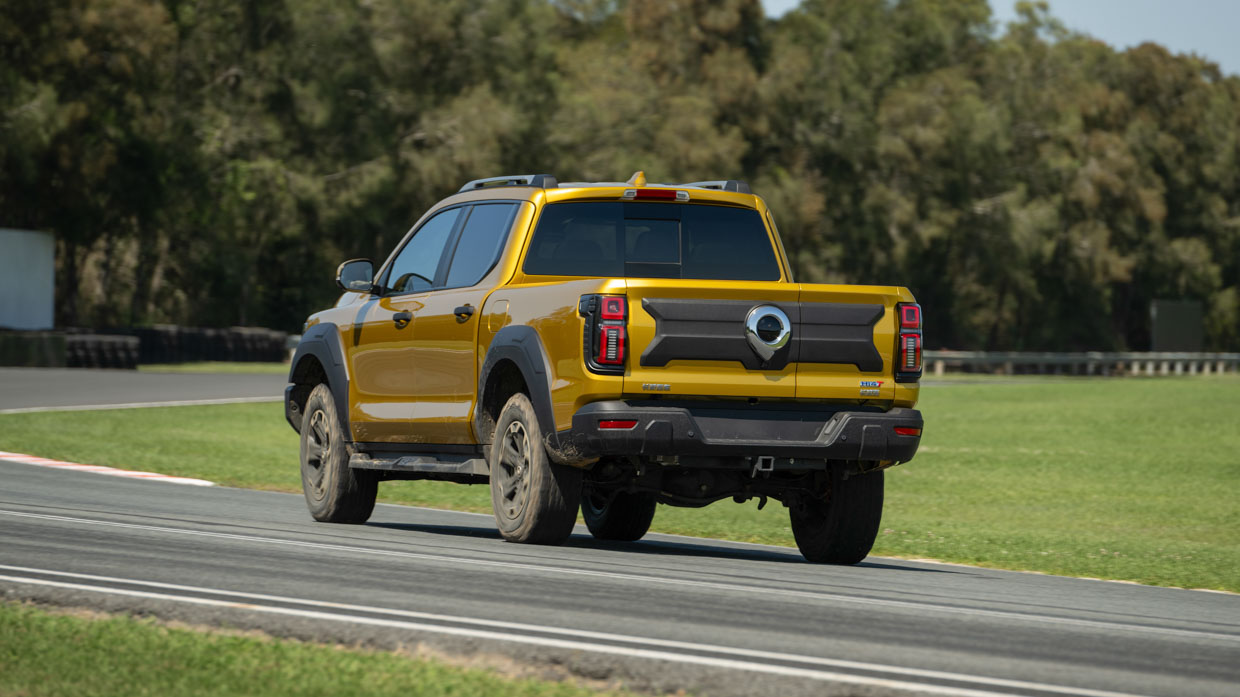
We selected what we believe was Sport mode (the display went red), and acceleration was spritely. The nine-speed auto gearbox with paddle shifters took a while to wake up, but the pull from petrol and electric combined gave decent urge.
We managed to do a launch in electric only, and it was clear there’s not the guts to move this weighty whopper in any great hurry using just battery power. Pleasingly, it managed to get up to 100km/h on a gentle throttle without thinking the combustion engine needed to chime again. Silent cruising was the result, albeit with some road noise.
The language barrier prevented us fully exploring its different powertrain modes. But the fact it can run as electric only, petrol only, a combination of the two, or as a series parallel hybrid (like a Toyota RAV4) gives the user plenty of fuel-saving options.
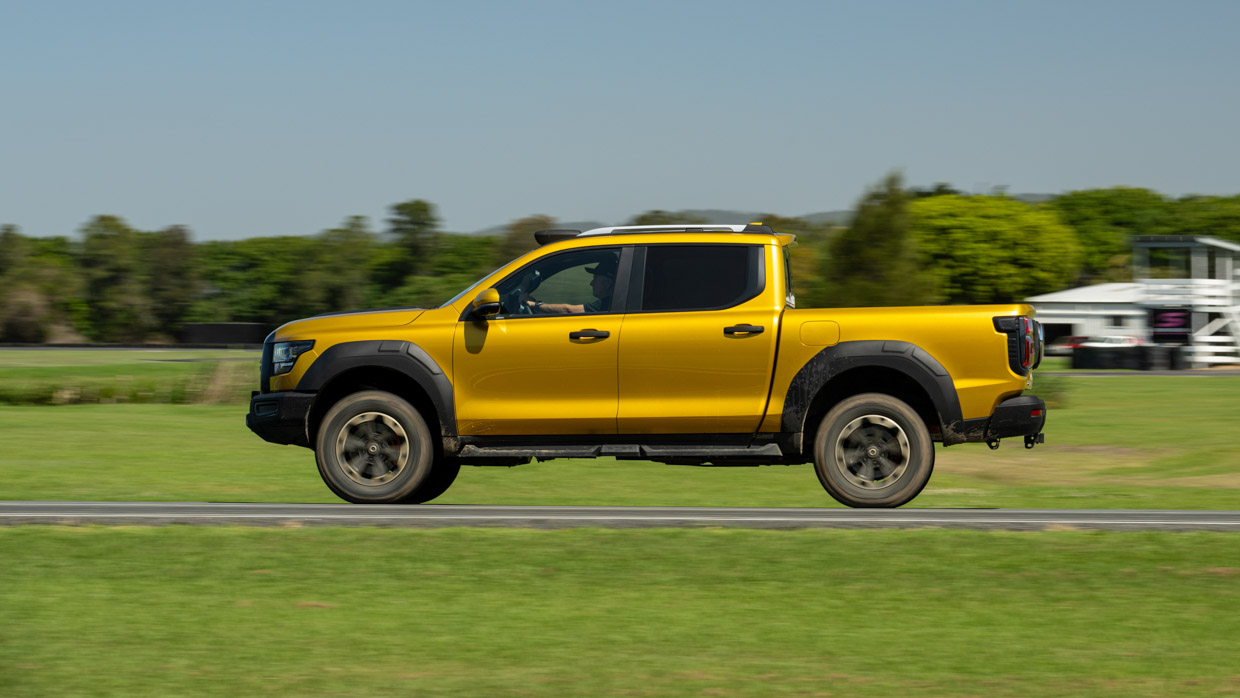
PHEV economy figures are pointless to quote because it depends on how it’s used and for how long, but the combined number we’re given is 1.7L/100km. With battery exhausted the petrol engine alone returns 9.3L/100km – not bad for a four-cylinder moving something with this heft.
You’d imagine it’d be a quite easy thing to live with, especially if GWM can better fine-tune its driver assist systems and make the screen menus a bit more common sense to navigate – aspects criticised in the Cannon Alpha Hybrid.
Our tester was lavished with interior luxury, and it’s a seriously roomy cabin with daylight pouring through the sunroof – it’s just a shame the glass doesn’t extend all the way back to the rear seats.
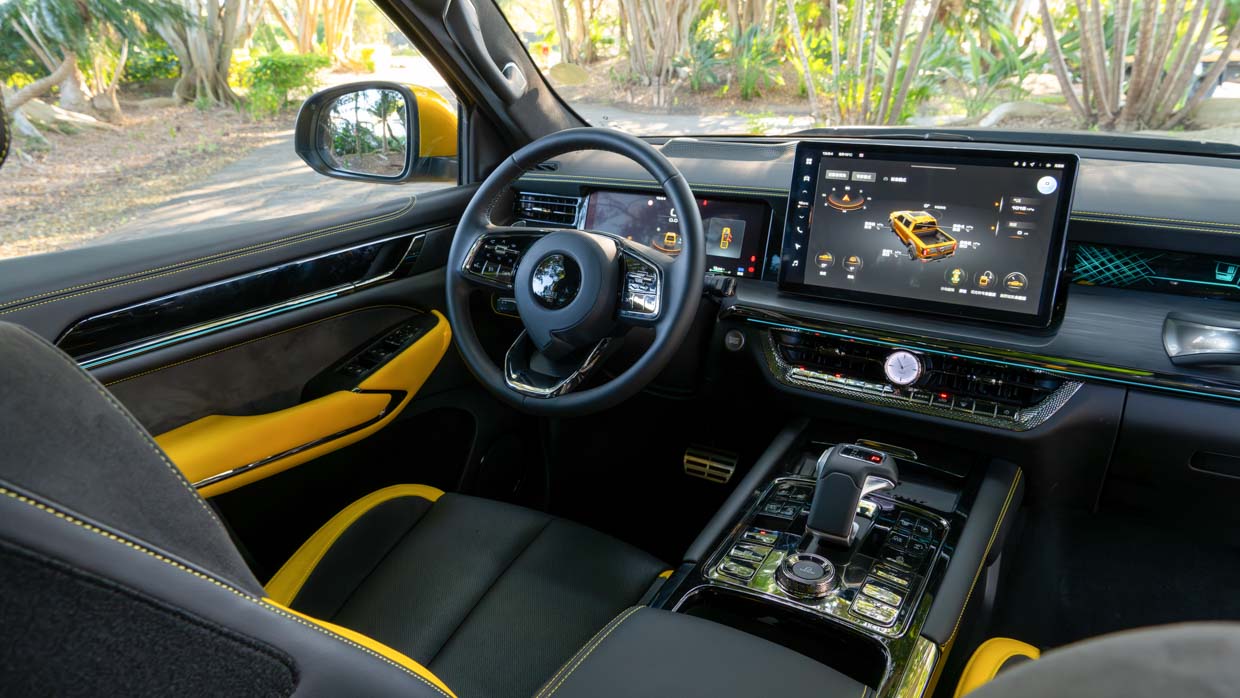
For some reason ours was gifted bright yellow cabin flashes for seat sides and armrests, distracting from an otherwise quite classy space. Seats are electric, heated and sink-in cossetting, while there’s soft plastics for door tops, dash and centre console – not always the case in utes.
There’s mighty storage, a chunky gear shifter, large wireless charge pad, plenty of physical buttons, a posh illuminated analogue clock and the world’s largest grab handle in front of the passenger.
Material quality’s not bad, but highlight is the 14.6-inch central infotainment screen, which despite its Chinese characters, proved swift operating and of decent resolution. It’s backed by a 12.3-inch digital driver display.
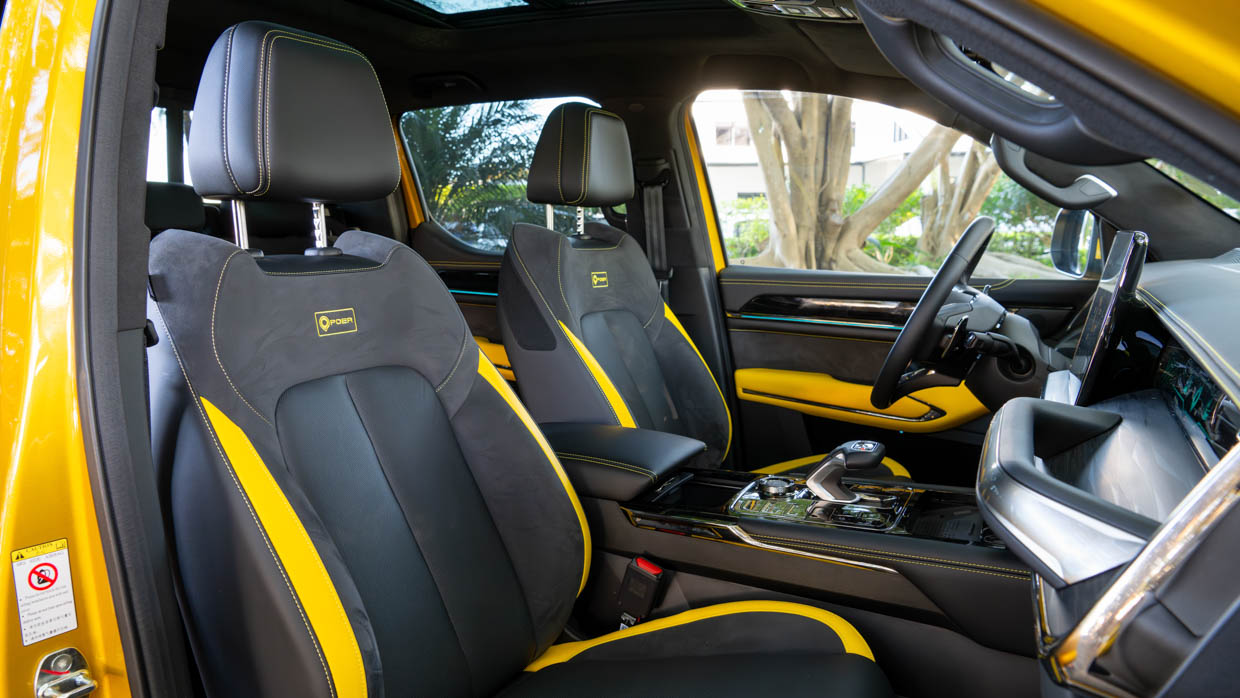
The 3350mm wheelbase rewards with giant rear seat space. While typical utes have very upright second row seats, this Alpha PHEV’s rear chairs automatically slide forward and offer a rear recline once you close the doors.
Add in heated rear seats and it’s rather limo-like. There are air vents, USB ports and another V2L socket back here, which are huge positives for family adventures.
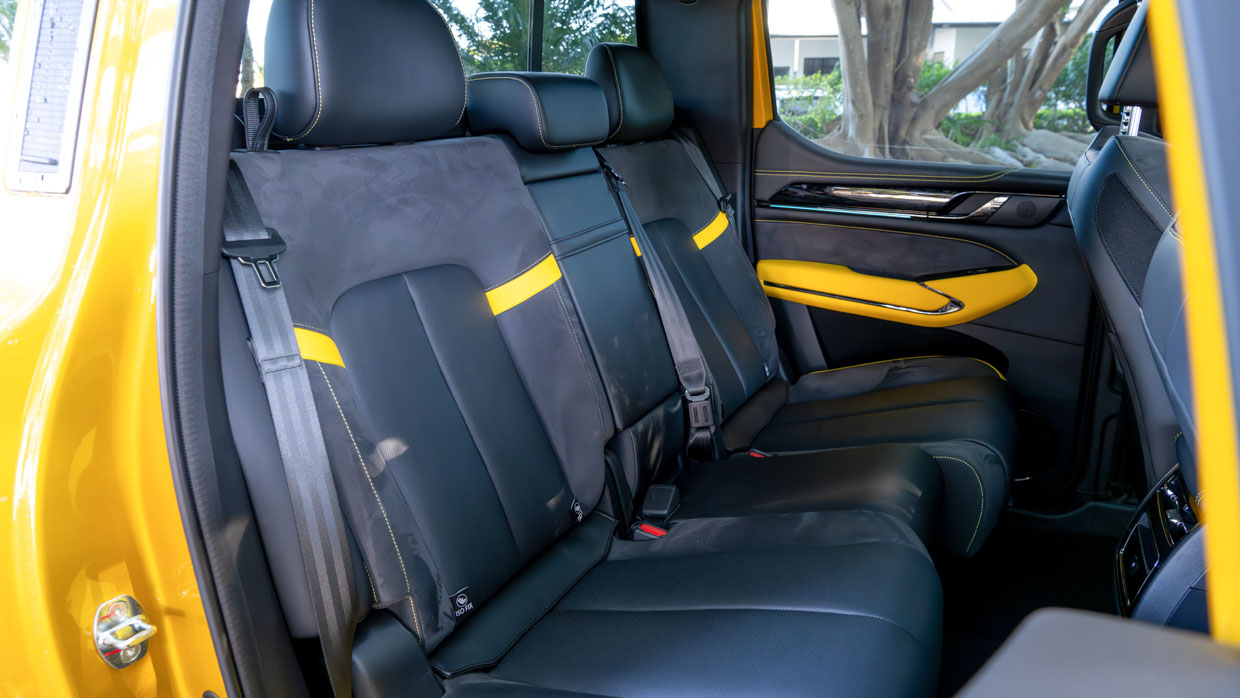
Is Australia keen on plug-in hybrid utes? We know Ford and BYD are locked in to bringing them, and it appears this Cannon Alpha PHEV will be next to join. There’s certainly not the compromises of full EV utes and pickups – 4×4 capabilities, range anxiety and charging infrastructure included.
The fact this Alpha can travel up to 110km on battery alone is as intriguing as it is potentially green, not least when you can climb mountains or traverse forest trails without spewing out diesel smoke nor noise pollution. It’s a blissful thing to drive as an EV only, and on first taste, capable off-road too.
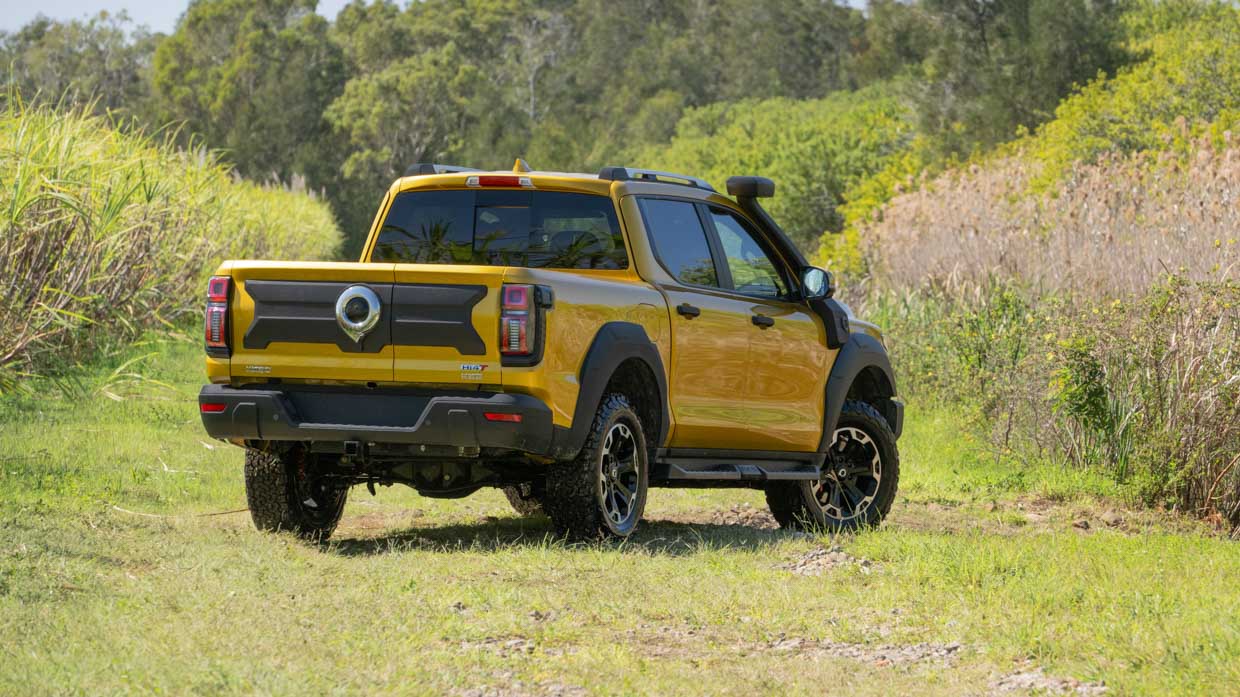
Impending NVES regulations may force brands’ hands, meaning GWM will look to sell enough of these PHEVs to balance its books, beside less eco-friendly hybrids and diesels.
So this PHEV’s selling price is key. GWM could lessen the luxe inside and the off-road gear outside to lower its price, although it’s clear as long as it stays under the FBT’s $90k limit, this XSR’s off-road ready kit will find favour with adventurous buyer types.
GWM’s seven-year warranty and five years of capped price servicing adds additional appeal, so it’d be a surprise if this ever-growing brand doesn’t have this point-of-difference plug-in ute in Aussie showrooms next year.
About Chasing cars
Chasing Cars reviews are 100% independent.
Because we are powered by Budget Direct Insurance, we don’t receive advertising or sales revenue from car manufacturers.
We’re truly independent – giving you Australia’s best car reviews.
The estimate provided does not take into account your personal circumstances but is intended to give a general indication of the cost of insurance, in order to obtain a complete quote, please visit www.budgetdirect.com.au. Estimate includes 15%^ online discount.
^Conditions Apply
Budget Direct Insurance arranged by Auto & General Services Pty Ltd ACN 003 617 909(AGS) AFSL 241 411, for and on behalf of the insurer, Auto & General Insurance Company Limited(ABN 42 111 586 353, AFSL 285 571).Because we don’t know your financial needs, we can’t advise you if this insurance will suit you. You should consider your needs and the Product Disclosure Statement before making a decision to buy insurance. Terms and conditions apply.
Indicative quote based on assumptions including postcode , 40 year old male with no offences, licence suspensions or claims in the last 5 years, a NCD Rating 1 and no younger drivers listed. White car, driven up to 10,000kms a year, unfinanced, with no modifications, factory options and/or non-standard accessories, private use only and garaged at night.
^Online Discounts Terms & Conditions
1. Discounts apply to the premium paid for a new Budget Direct Gold Comprehensive Car Insurance, Third Party Property Only or Third Party Property, Fire & Theft Insurance policy initiated online on or after 29 March 2017. Discounts do not apply to optional Roadside Assistance.
2. Discounts do not apply to any renewal offer of insurance.
3. Discounts only apply to the insurance portion of the premium. Discounts are applied before government charges, taxes, levies and fees, including instalment processing fees (as applicable). The full extent of discounts may therefore be impacted.
4. We reserve the right to change the offer without notice.